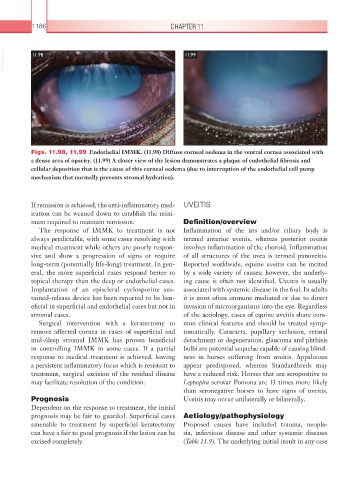Page 1211 - Equine Clinical Medicine, Surgery and Reproduction, 2nd Edition
P. 1211
1186 CHAPTER 11
VetBooks.ir 11.98 11.99
Figs. 11.98, 11.99 Endothelial IMMK. (11.98) Diffuse corneal oedema in the ventral cornea associated with
a dense area of opacity. (11.99) A closer view of the lesion demonstrates a plaque of endothelial fibrosis and
cellular deposition that is the cause of this corneal oedema (due to interruption of the endothelial cell pump
mechanism that normally prevents stromal hydration).
If remission is achieved, the anti-inflammatory med- UVEITIS
ication can be weaned down to establish the mini-
mum required to maintain remission. Definition/overview
The response of IMMK to treatment is not Inflammation of the iris and/or ciliary body is
always predictable, with some cases resolving with termed anterior uveitis, whereas posterior uveitis
medical treatment while others are poorly respon- involves inflammation of the choroid. Inflammation
sive and show a progression of signs or require of all structures of the uvea is termed panuveitis.
long-term (potentially life-long) treatment. In gen- Reported worldwide, equine uveitis can be incited
eral, the more superficial cases respond better to by a wide variety of causes; however, the underly-
topical therapy than the deep or endothelial cases. ing cause is often not identified. Uveitis is usually
Implantation of an episcleral cyclosporine sus- associated with systemic disease in the foal. In adults
tained-release device has been reported to be ben- it is most often immune mediated or due to direct
eficial in superficial and endothelial cases but not in invasion of microorganisms into the eye. Regardless
stromal cases. of the aetiology, cases of equine uveitis share com-
Surgical intervention with a keratectomy to mon clinical features and should be treated symp-
remove affected cornea in cases of superficial and tomatically. Cataracts, pupillary seclusion, retinal
mid-/deep stromal IMMK has proven beneficial detachment or degeneration, glaucoma and phthisis
in controlling IMMK in some cases. If a partial bulbi are potential sequelae capable of causing blind-
response to medical treatment is achieved, leaving ness in horses suffering from uveitis. Appaloosas
a persistent inflammatory focus which is resistant to appear predisposed, whereas Standardbreds may
treatment, surgical excision of the residual disease have a reduced risk. Horses that are seropositive to
may facilitate resolution of the condition. Leptospira serovar Pomona are 13 times more likely
than seronegative horses to have signs of uveitis.
Prognosis Uveitis may occur unilaterally or bilaterally.
Dependent on the response to treatment, the initial
prognosis may be fair to guarded. Superficial cases Aetiology/pathophysiology
amenable to treatment by superficial keratectomy Proposed causes have included trauma, neopla-
can have a fair to good prognosis if the lesion can be sia, infectious disease and other systemic diseases
excised completely. (Table 11.9). The underlying initial insult in any case

